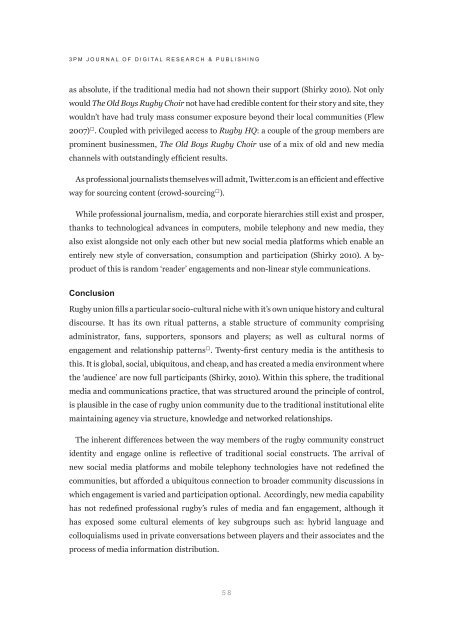3pm Journal of Digital research & publishing - artichoke web design
3pm Journal of Digital research & publishing - artichoke web design
3pm Journal of Digital research & publishing - artichoke web design
You also want an ePaper? Increase the reach of your titles
YUMPU automatically turns print PDFs into web optimized ePapers that Google loves.
<strong>3pm</strong> <strong>Journal</strong> <strong>of</strong> <strong>Digital</strong> <strong>research</strong> & <strong>publishing</strong><br />
as absolute, if the traditional media had not shown their support (Shirky 2010). Not only<br />
would The Old Boys Rugby Choir not have had credible content for their story and site, they<br />
wouldn’t have had truly mass consumer exposure beyond their local communities (Flew<br />
2007) � . Coupled with privileged access to Rugby HQ: a couple <strong>of</strong> the group members are<br />
prominent businessmen, The Old Boys Rugby Choir use <strong>of</strong> a mix <strong>of</strong> old and new media<br />
channels with outstandingly efficient results.<br />
As pr<strong>of</strong>essional journalists themselves will admit, Twitter.com is an efficient and effective<br />
way for sourcing content (crowd-sourcing � ).<br />
While pr<strong>of</strong>essional journalism, media, and corporate hierarchies still exist and prosper,<br />
thanks to technological advances in computers, mobile telephony and new media, they<br />
also exist alongside not only each other but new social media platforms which enable an<br />
entirely new style <strong>of</strong> conversation, consumption and participation (Shirky 2010). A by-<br />
product <strong>of</strong> this is random ‘reader’ engagements and non-linear style communications.<br />
Conclusion<br />
Rugby union fills a particular socio-cultural niche with it’s own unique history and cultural<br />
discourse. It has its own ritual patterns, a stable structure <strong>of</strong> community comprising<br />
administrator, fans, supporters, sponsors and players; as well as cultural norms <strong>of</strong><br />
engagement and relationship patterns � . Twenty-first century media is the antithesis to<br />
this. It is global, social, ubiquitous, and cheap, and has created a media environment where<br />
the ‘audience’ are now full participants (Shirky, 2010). Within this sphere, the traditional<br />
media and communications practice, that was structured around the principle <strong>of</strong> control,<br />
is plausible in the case <strong>of</strong> rugby union community due to the traditional institutional elite<br />
maintaining agency via structure, knowledge and networked relationships.<br />
The inherent differences between the way members <strong>of</strong> the rugby community construct<br />
identity and engage online is reflective <strong>of</strong> traditional social constructs. The arrival <strong>of</strong><br />
new social media platforms and mobile telephony technologies have not redefined the<br />
communities, but afforded a ubiquitous connection to broader community discussions in<br />
which engagement is varied and participation optional. Accordingly, new media capability<br />
has not redefined pr<strong>of</strong>essional rugby’s rules <strong>of</strong> media and fan engagement, although it<br />
has exposed some cultural elements <strong>of</strong> key subgroups such as: hybrid language and<br />
colloquialisms used in private conversations between players and their associates and the<br />
process <strong>of</strong> media information distribution.<br />
58


